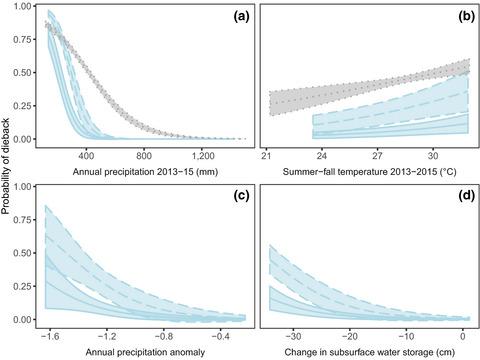当前位置:
X-MOL 学术
›
Glob. Change Biol.
›
论文详情
Our official English website, www.x-mol.net, welcomes your
feedback! (Note: you will need to create a separate account there.)
Weather underground: Subsurface hydrologic processes mediate tree vulnerability to extreme climatic drought.
Global Change Biology ( IF 10.8 ) Pub Date : 2020-03-24 , DOI: 10.1111/gcb.15026 Blair C McLaughlin 1 , Rachel Blakey 2 , Andrew P Weitz 3 , Xue Feng 4 , Brittni J Brown 5 , David D Ackerly 3 , Todd E Dawson 3 , Sally E Thompson 6, 7
Global Change Biology ( IF 10.8 ) Pub Date : 2020-03-24 , DOI: 10.1111/gcb.15026 Blair C McLaughlin 1 , Rachel Blakey 2 , Andrew P Weitz 3 , Xue Feng 4 , Brittni J Brown 5 , David D Ackerly 3 , Todd E Dawson 3 , Sally E Thompson 6, 7
Affiliation

|
Drought extent and severity have increased and are predicted to continue to increase in many parts of the world. Understanding tree vulnerability to drought at both individual and species levels is key to ongoing forest management and preparation for future transitions in community composition. The influence of subsurface hydrologic processes is particularly important in water-limited ecosystems, and is an under-studied aspect of tree drought vulnerability. With California's 2013-2016 extraordinary drought as a natural experiment, we studied four co-occurring woodland tree species, blue oak (Quercus douglasii), valley oak (Quercus lobata), grey pine (Pinus sabiniana), and California juniper (Juniperus californica), examining drought vulnerability as a function of climate, lithology and hydrology using regional aerial dieback surveys and site scale field surveys. We found that in addition to climatic drought severity (i.e. rainfall), subsurface processes explained variation in drought vulnerability within and across species at both scales. Regionally for blue oak, severity of dieback was related to the bedrock lithology, with higher mortality on igneous and metamorphic substrates, and to regional reductions in groundwater. At the site scale, access to deep subsurface water, evidenced by stemwater stable isotope composition, was related to canopy condition across all species. Along hillslope gradients, channel locations supported similar environments in terms of water stress across a wide climatic gradient, indicating that subsurface hydrology mediates species' experience of drought, and that areas associated with persistent access to subsurface hydrologic resources may provide important refugia at species' xeric range edges. Despite this persistent overall influence of the subsurface environment, individual species showed markedly different response patterns. We argue that hydrologic niche segregation can be a useful lens through which to interpret these differences in vulnerability to climatic drought and climate change.
中文翻译:

地下天气:地下水文过程调解了树木对极端气候干旱的脆弱性。
干旱的程度和严重性已经增加,预计在世界许多地方将继续增加。了解树木在个人和物种层面上对干旱的脆弱性,对于进行持续的森林管理以及为社区组成的未来过渡做好准备至关重要。地下水文过程的影响在缺水的生态系统中尤其重要,并且是树木干旱脆弱性研究不足的方面。以加利福尼亚州2013-2016年的特大干旱为自然实验,我们研究了四种同时出现的林木树种,蓝橡树(Quercus douglasii),谷栎(Quercus lobata),灰松(Pinus sabiniana)和加州杜松(Juniperus californica) ,考察干旱脆弱性与气候的关系,岩性和水文学,使用区域性空中平地调查和站点规模的野外调查。我们发现,除了气候干旱严重性(即降雨)以外,地下过程还解释了两个尺度上物种内部和物种之间干旱脆弱性的变化。在区域上,对于蓝橡树,枯死的严重程度与基岩岩性,火成岩和变质基质上的死亡率较高以及地下水的区域减少有关。在站点规模上,干水稳定同位素组成证明了对深层地下水的获取与所有物种的冠层状况有关。沿山坡坡度,河道位置在宽广的气候梯度上的水压力方面支持着相似的环境,这表明地下水文学可以调节物种的干旱经历,与持续获取地下水文资源有关的区域可能在物种的干性范围边缘提供重要的避难所。尽管受到地下环境的持续影响,但单个物种的反应方式却明显不同。我们认为,水文生态位隔离可以成为解释这些易受气候干旱和气候变化影响的差异的有用镜头。
更新日期:2020-04-22
中文翻译:

地下天气:地下水文过程调解了树木对极端气候干旱的脆弱性。
干旱的程度和严重性已经增加,预计在世界许多地方将继续增加。了解树木在个人和物种层面上对干旱的脆弱性,对于进行持续的森林管理以及为社区组成的未来过渡做好准备至关重要。地下水文过程的影响在缺水的生态系统中尤其重要,并且是树木干旱脆弱性研究不足的方面。以加利福尼亚州2013-2016年的特大干旱为自然实验,我们研究了四种同时出现的林木树种,蓝橡树(Quercus douglasii),谷栎(Quercus lobata),灰松(Pinus sabiniana)和加州杜松(Juniperus californica) ,考察干旱脆弱性与气候的关系,岩性和水文学,使用区域性空中平地调查和站点规模的野外调查。我们发现,除了气候干旱严重性(即降雨)以外,地下过程还解释了两个尺度上物种内部和物种之间干旱脆弱性的变化。在区域上,对于蓝橡树,枯死的严重程度与基岩岩性,火成岩和变质基质上的死亡率较高以及地下水的区域减少有关。在站点规模上,干水稳定同位素组成证明了对深层地下水的获取与所有物种的冠层状况有关。沿山坡坡度,河道位置在宽广的气候梯度上的水压力方面支持着相似的环境,这表明地下水文学可以调节物种的干旱经历,与持续获取地下水文资源有关的区域可能在物种的干性范围边缘提供重要的避难所。尽管受到地下环境的持续影响,但单个物种的反应方式却明显不同。我们认为,水文生态位隔离可以成为解释这些易受气候干旱和气候变化影响的差异的有用镜头。










































 京公网安备 11010802027423号
京公网安备 11010802027423号